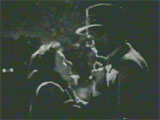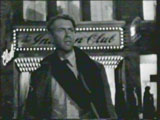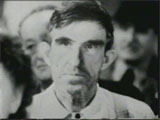|
|
|
Capra’s populism is white. I don’t need to explore that much; there are simply almost no blacks in any of his thirties films. It's difficult to identify a more complex ethnic component in Capra's populism because Capra was so loathe to speak of himself as an ethnic, though he was an Italian Catholic. "Who the hell cares where you were born," he commented in 1977 following a visit to the Sicilian town he had left 74 years earlier. "I hate the word roots," he remarked on another occasion, "people are so proud of their roots it's sickening." [Joseph McBride, Frank Capra: The Catastrophe of Success (NY: Simon & Schuster, 1992), 11.]
Nevertheless, there were roots that interested Frank Capra, the small-town American roots that were his only by adoption. His creations were continually informed and shaped by his status. That is, when I say his creations, I mean his films. [They] were continually informed
 |
Barbara Stanwyck and Gary Cooper in Meet John Doe.
28.8K
|
56K
|
and shaped by his status as a first-generation American making his claims on the heritage. Nor was Capra unique in this respect; the thirties was really a very interesting decade for this phenomenon. And now I’m going to block all the names—George Gershwin, Aaron Copeland, George Balanchine, and the one example I will give, Irving Berlin. We see the beginnings of a process that was to become prominent in the post-Depression decades. The torch of tradition was being passed to, or perhaps more accurately seized by, the very pariah immigrant groups who were so despised in the 1920s and who by the 30s began to not only expound, but to explain an America most of them had never experienced for themselves. They became not merely the receivers, but the bearers of the tradition. And an interesting Capra counterpart is Irving Berlin. Born Irving Israel Bailyn—I don’t know why he changed his name from Israel Bailyn to Irving Berlin, but he did—born Israel Bailyn in Russia in 1898, two years after Capra, or one year after Capra, and who wrote, as you know, one of America's most popular patriotic songs, "God Bless America" in 1913 (not to mention his songs about Easter, "Easter Parade" and "White Christmas"). Like Capra, Berlin had strong populist leanings and his creations were immediately popular with large numbers of Americans. When "God Bless America" was played at the start of a Brooklyn Dodgers ball game at Ebbetts Field on Memorial Day in 1939, the people in the stands—and this was not yet the habit in baseball games, that happened during World War II—the people in the stands spontaneously rose. Men took their hats off. School children began the day by singing the song. In 1940 both Democrats and Republicans featured the song in their national conventions and in their campaigns. Berlin himself refused to treat his song as a commercial property, giving all of the proceeds, throughout the life of the song's copyright, to the Boy and Girl Scouts of America. He was attacked by those who found it inappropriate for an immigrant Jew to write a song which combined the qualities of a religious hymn and a national anthem, which attempted to define America's relationship to God, and which threatened to usurp the "Star Spangled Banner" in the process. [Michael Freedland, Irving Berlin (NY: Stein and Day, 1974), 138-141; Laurence Bergreen, As Thousands Cheer: The Life of Irving Berlin (NY: Da Capo Press, 1996), 380-82.]
These complaints about Berlin, and there were some complaints about Capra as well, were eloquent testimonies to frustration at the complexity of a process of assimilation in which the assimilants can become the assimilators, a role Frank Capra assumed throughout the 1930s. If we're going to grasp more fully why and how traditional 19th-century ideals and values have continued to endure as well as they have amid the growing ethnic and cultural diversity of modern America we're going to have to become more conversant with the nature and meaning of careers like Frank Capra's.
 |
Jimmy Stewart searches for his town in It's A Wonderful Life.
28.8K |
56K
|
Finally, we have to recognize the ultimate pessimism, and this is important I think, the ultimate pessimism at the heart of Capra’s cultural politics. Capra’s determination to test the extent to which traditional values could be made to function, once again, in contemporary America, led him to progressively enlarge the scope of the urban dilemma. This is why his films are so great—his rural heroes' fates. So in Mr. Deeds, Deeds faces parochial New York snobbery, cynicism, and petty larceny. In Mr. Smith Goes To Washington, Smith faces the entrenched authority of the United States Senate, which Mr. Clinton is facing right now, and the political machines which dominated it. In Meet John Doe, Doe faces the massive power of a media baron determined to become a fascist dictator. He kept escalating to see if these values could be made to work, and of course, less and less could Capra find satisfactory, believable ways out of the impasse his representative hero found himself in.
Thus in every one of these films there is something that borders on a crucifixion scene, in which the hero finally learns that his ideals no longer work, resigns itself to his fate and prepares to sacrifice himself. The symbolism becomes most overt in Meet John Doe, when the hero plans to throw himself off City Hall on Christmas Eve, and the newspaper editor comments, "Well boys you can chalk up another one to the Pontious Pilates." The words crucifixion and crucify are used frequently in these films. In Mr. Deeds, Longfellow Deeds, informs us that his parents were named Joseph and Mary. But in no instance does Capra allow the hero to sacrifice himself. As Dwight McDonald remarked of Capra’s films, "There is something very American in the idea of an uncrucified Christ." [Quoted in Stephen Handzo, "A Decade of Good Deeds and Wonderful Lives UNDER CAPRACORN," Film Comment (Nov.-Dec., 1972), 12.]
Indeed, in one of the five different endings filmed for Meet John Doe, Capra actually allowed John Doe to jump to his death, an ending which he found esthetically and thematically correct. And it was both of those things. But he confessed that he didn’t dare use it, "You just don't kill Gary Cooper, it's a hell of a powerful ending, but you just can't kill Gary Cooper." [See Capra's conversation with Richard Glatzer, in Glatzer and Raeburn, eds., Frank Capra: The Man and His Films, 34. See also Capra, The Name Above the Title, chap. 16.] In commenting on Doe in his autobiography, Capra wrote, "We had shown the rise of two powerful opposing movements—one good, one evil. They clashed head on—and destroyed each other! St. George fought with the dragon, slew it, and was slain. What our film said to bewildered people hungry for solutions was this: 'No answers this time, ladies and gentlemen. It's back to the drawing board." [Capra, The Name Above the Title, 305.]
When Frank Capra finally emerged from his drawing board to create It’s A Wonderful Life, his first post-war film, his small-town hero no longer had to journey to the city to test his values, the city now came to him. But only an overt miracle in the shape of an angel named Clarence allowed him to even hold his own. The game was over. Traditional values were endangered not only in the modern city, but in the very precincts of the organic society itself. Capra had nothing left to say, which is why, with the possible exception of his 1948 state of the nation—I've forgotten the title of it—he never was to make another important film. I don’t think he lost his powers; he lost, in a way, his voice.
 |
The search for community in
Meet John Doe.
28.8K |
56K
|
Capra had grave doubts about, and criticisms of, large-scale corporate enterprise. In most of his Depression films, he found ways to reproach powerful capitalists for their values and their actions. Nevertheless, Capra’s films seem to imply that the problems Americans faced were due less to imperfections in the system than to human fallibility: to madness, irrationality, selfishness, greed. The crisis of the Great Depression challenged the soundness of the system and Capra responded, not as the Populists of the late 19th century had, by demanding changes in the political and economic system, but rather by reasserting his faith in the traditional verities and demanding changes in the individual. In his defense of traditional values and lifestyles, in his fear of the dangers of large institutions, in his preoccupation with old-fashioned individualism, in his search for community, in his concentration on the themes of regeneration and redemption, and indeed in many of his contradictions and confusions, Frank Capra was representative of many aspects of his time and his culture and, for better or worse, of ours as well.
Previous |
Next
Lawrence Levine
Part 1: Capra and the Politics of Culture
Part 2: Capra's Political Populism
Part 3: Capra's Fundamental Values
Part 4:
Pessimism in Capra's Cultural Politics
|



